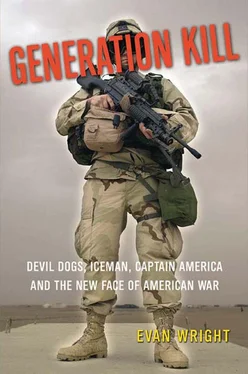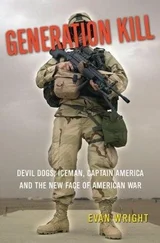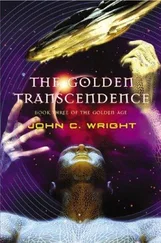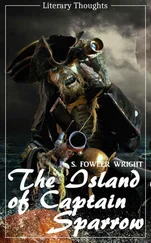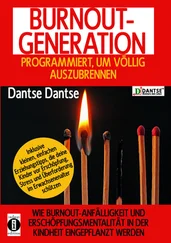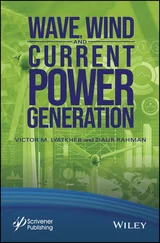We watch her flee. “Given the way things are going,” Fick says, “it’s probably wise of her to run when she sees Americans.”
ABOUT TWENTY MINUTES LATER, First Recon’s headquarters units roll past the blue car with the wounded man it. Navy Lieutenant Aubin, the battalion physician, insists on stopping so he can examine the driver.
What Aubin finds is yet another testament to the skills of the Marine Corps rifleman. Of the three rounds Hasser fired, one hit an occupant in the shoulder (whom we saw jump out), one skimmed into the hood and the third entered the driver’s left eye. The 5.56mm round then did a ninety-degree turn through the man’s brain and went straight up, exiting through the top of his skull. Basically, the man has been lobotomized. Aubin pokes and pinches the skin on the man’s upper body and finds he is totally unresponsive, a vegetable. But no arteries were hit. The light, venous bleeding from the entry and exit wounds is not enough to kill him. His breathing and heart rate are good.
Aubin concludes that in a hospital a man with these wounds could live indefinitely. Here, without care, he will die of starvation, infection or swelling of the brain. Unlike Doc Bryan, who was ready to shoot the man, acting as a vigilante mercy killer falls outside of everything Aubin believes in as a doctor. He administers morphine and Valium to quell any pain in case the victim comes to (which is medically possible), but not enough to kill him. He is torn by the dilemma posed by this patient. Aubin later tells me, “In the States we don’t practice euthanasia. If we remove someone from life support, I don’t make that decision. We have committees of doctors, lawyers, family members, clergy who all debate it.”
Aubin knows that to leave the man is a death sentence, but he decides not to call in a medevac. Marine resources are stretched thin. He leaves the man in the care of medical personnel with RCT-1, who will be holding the town. The wounded man dies, unclaimed by anyone, a day later. Marines don’t know anything about him other than that he was unarmed, behind the wheel of a blue car, when he drove onto a narrow, blacktop road where an American shot him in the eye.
°
WALTER HASSER, who shot the man in the blue car, is one of the most well-liked Marines in the platoon. He’s twenty-three years old, six feet two inches tall and knows the lyrics to just about every hit country song recorded between 1960 and 1974. Waylon Jennings and Johnny Cash are his heroes. He has a beautiful country singing voice, and in his case Colbert makes a special exemption to his “no country music” rule. Following the ZSU AAA gun attack south of Al Hayy during which Hasser had climbed into the turret under fire and had taken out the enemy gun position, the team had seized the bridge north of the town to the accompaniment of his singing Glen Campbell’s “Rhinestone Cowboy.”
Raised in a rented farmhouse in Louden County, Virginia, by a single mom who, he says, “didn’t have no college,” Hasser grew up working on farms and hunting. He seems like your basic country good old boy, but what he enjoys most about the Marine Corps is both the brotherhood and the diversity. “Back home you pal around with your own kind,” he says. “I never thought my best friends would be Mexicans. Here, we’re brothers, and we all look out for each other. That’s the best part of being in a war. We all get to be together.”
Earlier in the morning, when everyone had been complaining about the sorry state of MREs, Hasser had explained his basic philosophy of life. “Every chance you have, you should try to hook people up. People in the MRE factory don’t understand that. Hell, if I worked there I’d be sneaking in extra pound cakes, jalapeño cheese packs, Tootsie Rolls. You gotta throw things to people when you can.”
Now, driving out of Al Muwaffaqiyah, with the sound of that dying man’s gasping still fresh in everyone’s mind, Hasser stares out the window into a blazing sunset. The SAW is loose on his lap. His wrists are draped across the top of the weapon, but his fingers aren’t touching it, almost like he’s ignoring it.
“How are you doing?” I ask him.
“Just taking it all in,” he says.
THE OBJECTIVE TONIGHT on April 2 is to reach the outskirts of Al Kut, the Marine Corps’ goal in central Iraq. It’s about thirty kilometers north of Al Muwaffaqiyah. Before the Marines set out from Al Muwaffaqiyah, several old men on the road stopped Second Platoon, offering detailed information about ambushes ahead. Fick, Meesh and I talked to them for several minutes. One of the old men caught my eye. He pointed up the road and dragged his finger across his neck, making a throat-slashing gesture to indicate danger ahead.
Now, as we drive up the route in convoy with the battalion, Colbert picks up reports of sporadic gunfire from the radio. “We’re expecting enemy contact at the intersection two clicks up the road,” he says. “Person, get your NVGs out. This could go past dark.”
“One thing about the Marines,” Person says. “We always know how to wrap up a day.”
“Small-arms fire to the rear,” Colbert says.
“Yeah. Game on!” Trombley says excitedly from the turret. It’s his first time on the Mark-19, and he’s eager for the chance to blow stuff up with it.
“Stay frosty, Walt,” Colbert says.
“Yeah,” Hasser says.
I look over at him next to me. He’s still not touching the SAW. He’s just listlessly staring out the window. I’m glad of his humanity. The fact that he’s clearly so broken up by his shooting of that civilian just confirms what a decent guy he is. But I wish he wasn’t showing it right now.
We hit the intersection—the suspected ambush point, with berms on the left, a stand of palm trees on the right. No shots are fired.
“Stop!” Colbert says.
We halt between the trees and the berms in the suspected kill zone.
“What are we doing?” Person asks, his voice betraying a hint of nervousness.
“They want us to stop,” Colbert says. “I guess we’re trying to flush ’em out.”
We sit for several minutes, trying to bait the ambushers into shooting. Nobody says anything. It’s that leaden silence of old action movies where all you hear are heartbeats and watches ticking (though no one’s actually wearing a mechanical watch).
“Move up fifty meters,” Colbert says.
Again we sit in silence, broken abruptly when Trombley cuts a loud fart.
Everyone jumps. Nerves are so wired in the vehicle, some mistook it for the blast of a distant mortar.
“Jesus!” Colbert says.
“Sorry,” Trombley apologizes.
We creep forward. AKs crackle in the distance. We pick up speed, clearing the suspected ambush spot. We pass two black dogs humping in the ditch by the road. Then a billboard of a grinning Saddam.
“Hey, anybody got a Sharpie?” Person asks. “We should do some bathroom art on him, like draw a cock and balls going into his mouth. I’m serious, let’s stop and do it.” He starts laughing.
“Shush, Person. Take a deep breath,” Colbert says indulgently, like a kindergarten teacher with an unruly child.
“I can’t help it,” Person says. “I’m running solely on Ripped Fuel tonight.”
The sun is now a red disk perched just atop the horizon to the left. Several kilometers ahead, a massive fireball erupts, sending a mushroom cloud into the sky. The radios come to life, everyone debating what it is.
We stop, and for several moments the distant fireball burns more brightly than the setting sun. Now the feeling of being on a 1950s sci-fi movie is complete. Surrounded by the red, bermed fields, strange huts and now what look like two suns setting simultaneously, it’s like we’ve arrived on the alien planet.
Читать дальше
